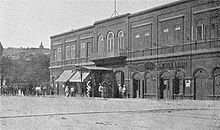Karl Gustav Hippius
Karl Otto Gustav Hippius ( Russian Карл Густавович Гиппиус ; * 1831 ; † August 22 . Jul / 3. September 1880 greg. In Saint Petersburg ) was a deutschbaltisch - Russian architect and watercolorist .
Life
Hippius was the son of the Baltic German painter and lithographer Gustav Adolf Hippius and brother of the architect Otto Pius Hippius . The grandfather was the Protestant pastor Thomas Hippius . Hippius received early instruction from his father in all artistic disciplines.
Hippius studied in St. Petersburg at the Imperial Academy of Arts , graduating as a freelance artist in 1855, after which he went on a study trip abroad at his own expense. On his return in 1857 he became an architect and artist for the Trans Caspian Trading Company and built warehouses in Astrabad and Baku .
In 1859 Hippius entered the service of the head office of the Caucasus governor. Hippius examined the consequences of the earthquake on December 2, 1859 in the provincial capital Schemacha , whereupon Baku became provincial capital and Hippius there became governor and city architect. Hippius shaped the cityscape of Baku by regulating the road system, creating the paved embankment and there next to the oldest Armenian Church of Our Lady the Church of Gregory the Illuminator (1863-1869) and houses for the governor (1865-1867), the aristocratic assembly and many private individuals built. He built three municipal wells and saved the Khan palace from being converted into a prison.
In 1867, Hippius became a government architect in Yerevan , where he built a prison and a bridge over the Aras . He went blind in one eye, his health deteriorated from the climate, and funicular myelosis was diagnosed. As a result, he took leave of absence in 1871 and returned to St. Petersburg for treatment. He took on private construction contracts there and was the architect of the Moscow Fire Insurance Company and the Nobility Assembly.
Hippius was an excellent watercolorist and was constantly painting landscapes and buildings. He gave his works to friends. An album with views of the Echmiadzin monastery has been preserved.
Hippius died after a heart attack and was buried in St. Petersburg in the Smolensk cemetery in the Lutheran department. His son was the architect Karl Karlowitsch Hippius .
literature
- PE : Hippius, Karl Gustav . In: Hans Vollmer (Hrsg.): General lexicon of fine artists from antiquity to the present . Founded by Ulrich Thieme and Felix Becker . tape 17 : Heubel – Hubard . EA Seemann, Leipzig 1924, p. 124 .
Web links
- Baltic Historical Commission (Ed.): Entry on Karl Gustav Hippius. In: BBLD - Baltic Biographical Lexicon digital
Individual evidence
- ^ Baltic Historical Commission (ed.): Entry on Hippius, Gustav Adolf. In: BBLD - Baltic Biographical Lexicon digital
- ↑ a b c d e f Гиппиус, Карл Густавович . In: Русский биографический словарь . tape 5 , 1916, pp. 228 ( Wikisource ).
- ↑ некролог . In: Зодчий . 1880, p. 75 .
- ↑ Н. Чулков: Гиппиус, Густав (Густав Адольф) Фомич . In: Русский биографический словарь . tape 5 , 1916, pp. 226-227 ( Wikisource ).
- ↑ Краткий очерк истории бакинской церкви Св. Григория Просветителя. A Brief Review of the History of St.Gregory the Illuminator Church in Baku (accessed May 13, 2018).
| personal data | |
|---|---|
| SURNAME | Hippius, Karl Gustav |
| ALTERNATIVE NAMES | Гиппиус, Карл Густавович (Russian) |
| BRIEF DESCRIPTION | German-Baltic-Russian architect and watercolorist |
| DATE OF BIRTH | 1831 |
| DATE OF DEATH | September 3, 1880 |
| Place of death | St. Petersburg |

